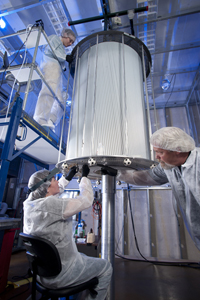GlueX Experiment
CMU Building Particle Detector To Shed Light On What Holds Matter Together
By Jocelyn Duffy
 You can find some out-of-the-ordinary items hidden behind the doors of the hundreds of Carnegie Mellon laboratories. Such is the case in the lab of Physics Professor Curtis Meyer, where you’ll find something extraordinary and rarely seen on a university campus.
You can find some out-of-the-ordinary items hidden behind the doors of the hundreds of Carnegie Mellon laboratories. Such is the case in the lab of Physics Professor Curtis Meyer, where you’ll find something extraordinary and rarely seen on a university campus.
On the eighth floor of Wean Hall is a Class 2000 clean room. The room is specially designed to prevent airborne pollutants from entering its protective plastic-walled chamber. Hanging from the ceiling is a particle detector. At any given time of the day, students and technicians clothed in protective jumpsuits and caps hover on ladders above or sit below the detector, painstakingly installing delicate pieces.
Building such a detector is a precise process that is usually only done at large national laboratory facilities such as Chicago’s Fermilab, or California’s SLAC National Accelerator Laboratory.
“Very few places have the infrastructure necessary to build a detector,” Meyer said. “We’re very fortunate to have the expertise and resources to build this here.”
The expertise comes through Meyer, lead scientist Naomi Jarvis, and technicians Gary Wilkin, Amy Woodhall and Kaitlin Mueller, who combined have decades of experience in detector construction and research. Two students, Maddison Brumbaugh and Rahul Kurl, are assisting. Meyer estimates that around 20 students have worked on the project since construction began in 2009.
The detector consists of a reaction chamber surrounded by 3,522 5-foot-long aluminum and plastic tubes. Secured between two plates, the tubes are being layered in 28 concentric circles. Gold-plated tungsten wire five times thinner than a human hair will be threaded down each tube. In all, it will take 3 miles of wire and countless hours to assemble.
When it’s finished in 2013 the detector will travel to the Jefferson Lab National Accelerator Facility (JLab) in Newport News, Va. There it will be installed as part of the Department of Energy-funded GlueX experiment, which seeks to find a new type of subatomic particle called a hybrid meson. The particle should reveal pertinent information about gluons — the stuff that holds everyday matter together.
Gluons bind together the component parts of protons and neutrons called quarks. Mesons are particles made up of a pair of quarks held together by gluons with no charge. The gluons in hybrid mesons — which have been theorized and hinted at in experiments, but never before seen — are thought to be in an exited state. This gives the mesons unusual, or “exotic,” quantum numbers that are a signature of the hybrid particles. Meyer and his collaborators hope that by detecting these hybrid mesons they will be able to derive pertinent information about gluons.
To find exotic mesons, researchers will employ the JLab Continuous Electron Beam Accelerator. Accelerated by 12 billion volts, electrons will be hurled around a 7/8 mile circular track. The electrons will be extracted from the track and passed through a thin diamond crystal, causing them to emit high-energy photons — the elementary particles of light. The photons will be aimed at a liquid hydrogen target at the center of the detector. When they hit the target, they will produce a variety of subatomic particles that will soar out from the central target and pass through the tubes of the detector. The tubes will be filled with a mixture of argon and carbon dioxide gas that will ionize when the particles fly through it, sending an electrical current through the wires at the center of the tubes.
“Each of the tubes will be an individual Geiger counter,” Meyer said. “We’ll have 3,522 Geiger counters generating information about the particles created by the collision.”
The researchers will analyze the trajectory of each particle. Based on the trajectory, they’ll be able to calculate the mass and other characteristics of the particles.
The detector will be delivered to the Virginia lab in 2013, and Meyer expects that the experiment will be fully operational in 2015. It will represent the first time large amounts of data have been taken from photons.
“Previous experiments using photon beams were only able to collect small amounts of data. In GlueX, we will increase the world’s statistical data from photon beams by several orders of magnitude,” Meyer said. “This will make the detailed study of the physics behind the reactions possible and allow us to see the exotic hybrid mesons — if they exist.”
Meyer expects the data set to be in petabytes — 1,015 bytes. While this much data could be daunting, the multi-institutional group working on the JLab experiment has come up with a relatively low-tech way to analyze the information using standard computer video processors. These processors are so small that they can fit 1,024 of them in the space of one hard drive.
“It turns out that graphical processor units can do the types of calculations we need faster than most other processors,” Meyer said. “It only works on specific types of problems; luckily ours was one of them.”
When the Glue-X team begins collecting and analyzing data, they hope to piece together how gluons and quarks interact. They will compare what they learn to current theories, like the theory of quantum chromodynamics.
“We hope to reach a fundamental understanding of how these particles behave. It’s going to give us a better idea of how the fundamental pieces of the universe work,” said Meyer. “And that’s exciting.”
Team members, clockwise from top, Maddison Brumbaugh, a junior in applied physics and international relations and politics, and Gary Wilkin and Amy Woodhall, physics technicians, work on threading wire through each tube in a reaction chamber on a particle detector being built at Carnegie Mellon.
